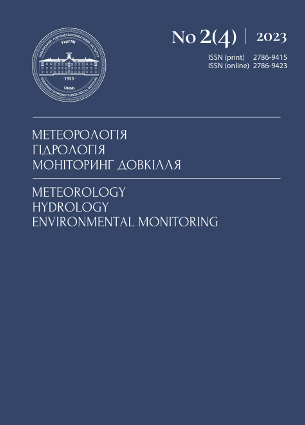SPREADING OF THE EXTREME WATER DISCHARGE FROM THE DNIPRO-BUH ESTUARY INTO THE BLACK SEA IN JUNE 2023 BY SATELLITE OBSERVATIONS DATA
Abstract
References
1. Grishin G.A., Ilyin Y.P. (1983). Variability of oceanographic fields in the northwestern part of the Black Sea based on satellite video data. Methods of the Space Oceanographic Information Processing. Sevastopol: MHI. 78-83. [In Russian]
2. Grishin G.A., Ilyin Y.P., Nelepo A.B., et al. (1984). Interpretation of cosmic images of the sea surface using a digital processing complex SVIT. Earth Exploration from Space, 6. 28-35. [In Russian]
3. Ivanov V.A., Ilyin Y.P. (1995). Atmospheric and hydrological conditions that promote riverine water expansion in the north-western part of the Black Sea. Comprehensive Environmental Studies of the Black Sea. Sevastopol: MHI. 68-81. [In Russian]
4. Ilyin Y.P. (1999). Expansion of the riverine water. Natural conditions of the seaside of the Danube River and the Snake Island. Ivanov V.A., Goshovsky S.V. (eds). Sevastopol: MHI. 5-73. [In Russian]
5. Ilyin Y.P. (2006). Hydrological regime of riverine waters expansion in the North-Western part of the Black Sea. Scientific works of UHMI, 255. 242-251. [In Russian]
6. Ilyin Yu.P. (2022). Average long-term values and variability of water, salt and dissolved nutrient flows in the system of the Dnieper-Bug estuary. Meteorology. Hydrology. Environmental monitoring, 2. 71-80. [In Ukrainian]
7. Ilyin Yu.P. (2023). Average condition and seasonal variability of the structure and dynamics of transitional waters in the Dnieper-Bug estuary region. Ukrainian Hydrometeorological Journal, 32. 63-79. DOI: 10.31481/uhmj.32.2023.05 [In Ukrainian]
8. Ilyin Y.P., Grishin G.A., Bikbaeva R.A. (1986). Salinity Field Variability and Dynamics of the Northwestern Black Sea. Non-Contact Methods and Instruments for the Oceanographic Parameters Measuring. Moscow: Nauka. 171-174. [In Russian]
9. Ilyin Y.P., Grishin G.A. (1988). Summer desalination of the northwestern part of the Black Sea and the possibility of its control by satellite video data. Geographical interpretation of aerospace information. Moscow: Nauka. 119-125. [In Russian]
10. Ilyin Y.P., Repetin L.N., Belokopytov V.N. et al. (2012). Hydrometeorological conditions of the Ukrainian seas. Vol. 2: The Black Sea. Sevastopol: MB UHMI. 421. [In Russian]
11. Tuchkovenko Yu.S., Kushnir D.V., Ovcharuk V.A., et al. (2023). Characteristics of Black Sea dispersion of freshened and polluted transitional waters from the Dnipro-Bug estuary after destruction of the Kakhovka reservoir dam. Ukrainian Hydrometeorological Journal, 32. 95-114. DOI: 10.31481/uhmj.32.2023.07 [In Ukrainian]
12. Carlson R.E. (1977). A trophic state index for lakes. Limnology and Oceanography, 22 (2). 361–369.
13. Gordon H.R. (2019). Physical Principles of Ocean Color Remote Sensing. University of Miami. 995. DOI: 10.33596/ppocrs-19
14. Gordon H.R., Morel A.Y. (1983). Remote Assessment of Ocean Color for Interpretation of Satellite Visible Imagery (A Review). Springer-Verlag, New York. 114. DOI: 10.1029/LN004
15. Hu C., Lee Z., Franz B. (2012). Chlorophyll a Algorithms for Oligotrophic Oceans: A Novel Approach Based on Three-band Reflectance Difference. J. Geophys. Res., 117, C01011. 25. DOI:10.1029/2011JC007395.
16. Oreshchenko A. (2023) Draining of the Kahovka Water Reservoir Caused by the Russian Blowing of the Hydroelectric Plant Dam. International Conference of Young Scientists on Meteorology, Hydrology and Environmental Monitoring (November 15-16, 2023, Kyiv, Ukraine). Ukraine: Kyiv. 34.
17. United Nations Environment Programme. (2023). Rapid Environmental Assessment of Kakhovka Dam Breach; Ukraine, 2023. Nairobi, Kenya. DOI: 10.59117/ 20.500.11822/43696
18. Vyshnevskyi V., Shevchuk S., Komorin V., et al. (2023). The Destruction of the Kakhovka Dam and its Consequences. Water International, published online. 17. DOI: 10.1080/02508060.2023.2247679

